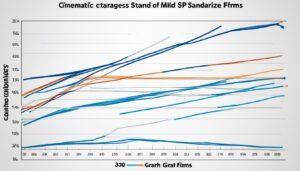Performance testing is an essential and vital component of the software development process. It helps to ensure that software applications perform optimally and meet the required standards and expectations of users. For software testers, mastering performance testing skills is a must-have skillset, and becoming a certified JMeter professional is a great way to demonstrate mastery of those skills. In this article, we will explore how to simulate performance testing scenarios for JMeter certification exams.
The importance of simulating performance testing scenarios for JMeter certification exam
Simulating performance testing scenarios using JMeter is essential for testers who want to become certified JMeter professionals. Simulations ensure that JMeter certification candidates have a comprehensive understanding of performance testing basics and can successfully design, create, and execute relevant performance test scenarios. With robust simulations, candidates can gain hands-on experience, identify performance bottlenecks, troubleshoot issues, and ultimately deliver optimal software performance.
Moreover, simulating performance testing scenarios also helps JMeter certification candidates to understand the impact of different variables on software performance. By manipulating variables such as user load, network bandwidth, and server response time, candidates can observe how these factors affect the overall performance of the software. This knowledge is crucial for testers who want to optimize software performance and ensure that it meets the required standards. Therefore, simulating performance testing scenarios is not only important for passing the JMeter certification exam but also for enhancing the skills and expertise of performance testers.
Understanding the basics of JMeter performance testing
JMeter is an open source tool that is widely used for performance testing. It can simulate multiple users, browser behaviors, and network conditions. Testers utilize JMeter to subject software applications or web APIs to a range of tests, including load testing, stress testing, and endurance testing, among others. JMeter leverages virtual user groups, requests, and samplers to generate realistic usage patterns and simulate the behavior of real users.
One of the key advantages of JMeter is its ability to generate comprehensive reports that provide detailed insights into the performance of the application or API being tested. These reports can help testers identify bottlenecks, pinpoint areas for improvement, and optimize the performance of the system. Additionally, JMeter supports a wide range of protocols, including HTTP, FTP, JDBC, and SOAP, making it a versatile tool for testing a variety of applications and systems.
However, it is important to note that JMeter can be complex and challenging to use, particularly for testers who are new to performance testing. It requires a solid understanding of the underlying technologies and protocols, as well as the ability to design effective test plans and scenarios. As such, it is recommended that testers undergo training and gain experience with JMeter before attempting to use it for complex performance testing tasks.
Selecting the best simulation tools for your JMeter certification exam
When it comes to simulating performance testing scenarios, it’s crucial to choose the right tools for the job. Some essential tools for simulating JMeter performance testing scenarios include LoadRunner, Gatling, and Apache AB. Paying attention to the specific requirements and limitations of each tool will help you choose the most suitable one for your certification exam simulation needs.
LoadRunner is a popular tool for simulating JMeter performance testing scenarios. It offers a wide range of features and supports multiple protocols, making it a versatile tool for performance testing. However, it can be expensive and may require a significant amount of resources to run.
Gatling is another tool that is gaining popularity among performance testers. It is an open-source tool that is easy to use and offers a user-friendly interface. It also supports multiple protocols and can simulate large numbers of users. However, it may not be as feature-rich as some of the other tools available.
Designing and creating your own performance testing scenarios in JMeter
Designing and creating a performance testing scenario in JMeter requires a test plan. The test plan outlines the sequence of actions and conditions to simulate, the number of users or threads to simulate, and the number of times to repeat each action or condition. Proper planning is essential to ensure that testing is comprehensive and that all essential elements are covered.
It is also important to consider the environment in which the performance testing will take place. Factors such as network bandwidth, server capacity, and database performance can all impact the results of the testing. It is recommended to conduct testing in a staging or testing environment that closely mirrors the production environment to ensure accurate results. Additionally, it is important to monitor the performance metrics during testing to identify any bottlenecks or areas for improvement.
Tips for effective performance test scenario simulation in JMeter
Effective simulation requires attention to detail, preparation, and consistency. Testers need to set up test environments that closely resemble real-life scenarios and incorporate data and traffic that reflect expected production usage. Additionally, generate meaningful test reports, analyze results, and highlight the critical bugs and performance bottlenecks discovered during simulation testing.
One important aspect of effective performance test scenario simulation in JMeter is to ensure that the test environment is stable and consistent. This means that the environment should be free from any external factors that may affect the test results, such as network congestion or server downtime. Testers should also ensure that the test environment is properly configured and optimized to handle the expected load.
Another key factor in effective performance test scenario simulation is to use realistic test data. Testers should use data that closely resembles the data that will be used in production, including data volume, data types, and data formats. This will help to ensure that the test results accurately reflect the performance of the system under real-world conditions.
How to identify and troubleshoot issues during performance testing simulations
During simulation testing, it’s common to experience performance issues and software bugs. Identifying and troubleshooting issues requires a structured and strategic approach. Start by analyzing test reports to identify areas that require further investigation. Advancing to diagnose and troubleshoot issues, use different tools, including logs, statistics data, and network analyzers to isolate the root cause. Remember, for successful testing, resolving identified bugs and performance bottlenecks is essential.
It’s important to note that performance issues can also be caused by external factors, such as network latency or server overload. To account for these factors, it’s recommended to conduct testing in a controlled environment that closely mimics the production environment. Additionally, it’s crucial to involve all stakeholders in the testing process, including developers, testers, and system administrators, to ensure that all potential issues are identified and addressed.
Best practices for recording and analyzing simulation results in JMeter
Simulating performance testing scenarios generates massive amounts of data. Recording and analyzing simulation results using JMeter require following best practices. These include generating test reports at regular intervals, highlighting key performance statistics, visualizing test results graphically, and sharing test results with all relevant stakeholders.
Another important best practice for recording and analyzing simulation results in JMeter is to use appropriate naming conventions for test plans, thread groups, and samplers. This helps in organizing and identifying test results easily. Additionally, it is recommended to use assertions to validate the response data and ensure that the application is functioning as expected.
Furthermore, it is important to consider the hardware and network configurations while recording and analyzing simulation results. The performance of the application can be affected by factors such as CPU usage, memory usage, network bandwidth, and latency. Therefore, it is recommended to monitor these metrics during the test execution and analyze their impact on the application’s performance.
Common mistakes to avoid during JMeter performance testing simulations
While simulating test scenarios using JMeter, it’s important to avoid common mistakes that could lead to invalid or unreliable results. These mistakes could include failing to consider test environment limitations, overlook potential performance bottlenecks, ignoring real-life usage patterns, and failing to correctly configure JMeter test plans, among others. Testers should adhere to best practices and enable efficient and effective performance testing.
One additional mistake to avoid during JMeter performance testing simulations is failing to properly analyze and interpret test results. It’s important to not only run the tests but also to analyze the results to identify any performance issues and determine the root cause. Testers should also compare the results with the expected performance metrics and identify any deviations. Proper analysis and interpretation of test results can help improve the overall performance of the application and ensure that it meets the desired performance standards.
Advantages of simulating performance testing scenarios before taking the JMeter certification exam
Simulating performance testing scenarios before taking the JMeter certification exam offers candidates a range of advantages. Through simulations, candidates get a chance to gain hands-on experience with JMeter, understand performance testing basics, identify and troubleshoot common performance issues, and build test acceptance criteria. Additionally, simulations help candidates understand the examination structure, format, and criteria, improving their chances of success.
Another advantage of simulating performance testing scenarios before taking the JMeter certification exam is that it helps candidates to identify and address any knowledge gaps they may have. By working through different scenarios, candidates can identify areas where they may need to improve their understanding of JMeter or performance testing concepts. This can help them to focus their study efforts and ensure that they are fully prepared for the exam.
Finally, simulating performance testing scenarios can help candidates to build confidence in their abilities. By working through different scenarios and successfully identifying and addressing performance issues, candidates can feel more confident in their ability to use JMeter effectively. This can help to reduce exam anxiety and improve overall performance on the day of the exam.
Preparing for the unexpected: How to handle errors during simulation testing in JMeter
During simulation testing, testers should plan for the unexpected. The performance testing environment mirrors a real-life environment; thus, unexpected errors are common. To handle issues that arise during testing, testers should have a contingency plan in place. These may include defining and executing recovery protocols in case of hardware or software failures, periodic backup of data, and maintaining an up-to-date disaster recovery plan.
It is also important for testers to document any errors that occur during simulation testing. This documentation should include the error message, the time and date of occurrence, and any relevant information about the test environment. This information can be used to troubleshoot and resolve issues that arise during testing, as well as to improve the overall performance of the system being tested.
Advanced techniques for complex performance test scenario simulations in JMeter
As a tester becomes more experienced with JMeter, they will encounter more complex performance testing scenarios. More advanced techniques to simulate complex scenarios include parameterization, correlation, loops, and conditional statements, among others. By mastering advanced techniques in JMeter, testers gain the skills needed to simulate complex scenarios and certification exam simulations.
One of the most important advanced techniques in JMeter is parameterization. This technique allows testers to create dynamic test scenarios by replacing hard-coded values with variables. Parameterization is particularly useful when testing web applications that require user input, as it allows testers to simulate different user behaviors and inputs.
Another advanced technique in JMeter is correlation. Correlation is the process of extracting dynamic values from server responses and using them in subsequent requests. This technique is essential when testing web applications that use session IDs or other dynamic values to maintain state between requests. By correlating these values, testers can create more realistic test scenarios and identify performance issues that may not be apparent with static values.
Frequently asked questions about simulating performance testing scenarios for JMeter certification exam
What are the benefits of simulating performance testing scenarios in JMeter? How do I set up a JMeter test plan? What tools do I use for generating meaningful test reports? How do I troubleshoot performance issues? These are among the questions frequently asked by testers looking to simulate performance testing scenarios. Understanding the responses to frequently asked questions can help testers optimize their JMeter simulation testing experience.
Conclusion
Simulating performance testing scenarios using JMeter is an essential component of becoming a certified JMeter professional. Testers who adequately plan, strategize, and consult best practices can efficiently and effectively simulate performance testing scenarios, troubleshoot issues, and generate comprehensive performance test reports. Adhering to best practices, mastering advanced techniques, and keeping abreast of various tools enables testers to become JMeter certified professionals and excel in their work.







